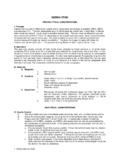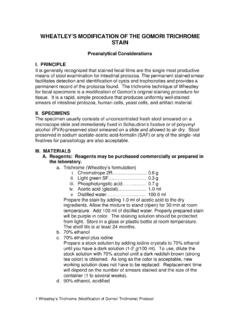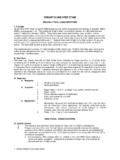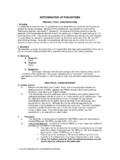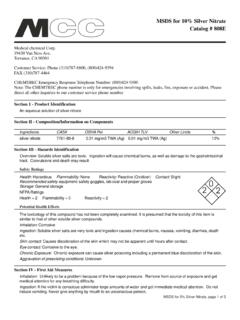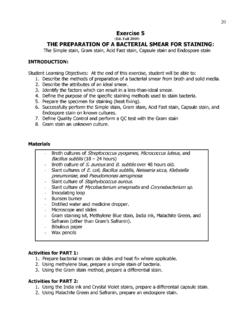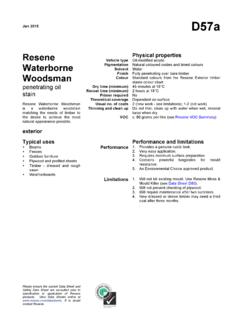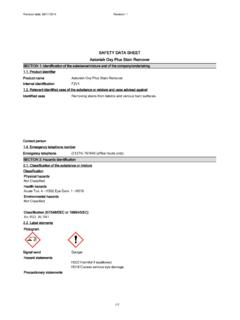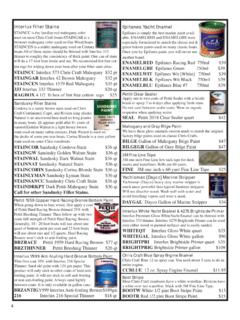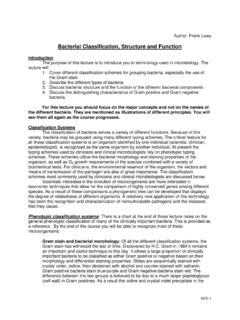Transcription of GRAM STAIN PROTOCOL - Med-Chem
1 1 gram STAIN PROTOCOL gram STAIN Preanalytical Considerations I. PRINCIPLE The gram STAIN is used to classify bacteria on the basis of their forms, sizes, cellular morphologies, and gram reactions; in a clinical microbiology laboratory, it is additionally a critical test for the rapid presumptive diagnosis of infectious agents and serves to assess the quality of clinical specimens. The test was originally developed by Christian gram in 1884, but was modified by Hucker in 1921. The modified procedure provided greater reagent stability and better differentiation of organisms. Other modifications have been specifically developed for staining anaerobes and for weakly staining gram -negative bacilli (Legionella spp., Campylobacter spp., Bacteroides spp. Fusobacterium spp., Brucella spp.) by using a carbol-fuchsin or basic fuchsin counterstain. Interpretation of gram -stained smears involves consideration of staining characteristics and cell size, shape, and arrangement.
2 These characteristics may be influences by a number of variables, including culture age, media, incubation atmosphere, staining methods, and the presence of inhibitory substances. Similar considerations apply to the interpretation of smears from clinical specimens, and additional factors include different host cell types and possible phagocytosis. gram STAIN permits the separation of all bacteria into two large groups, those which retain the primary dye ( gram -positive) and those that take the color of the counterstain ( gram -negative). The primary dye is crystal violet and the secondary dye is usually either safranin O or basic fuchsin. Some of the more common formulations include: saturated crystal violet (approximately 1%), Hucker s crystal violet, and 2% alcoholic crystal violet. II. SPECIMENS Smears for gram STAIN may be prepared from clinical specimens, broth cultures, or colonies growing on solid media. Young cultures (<24 h) from noninhibitory media and fresh clinical specimens yield the most accurate results, and for some morphological parameters, broth culture smears are recommended.
3 III. MATERIALS A. Reagents: Reagents may be purchased commercially or prepared in the laboratory. The various gram STAIN modifications and used are seen in Table 1. a. Hucker s modification i. Crystal violet ii. gram s iodine: Caution: Iodine is corrosive. Avoid inhalation, ingestion, or skin contact. iii. Decolorizers 1. Slowest: ethanol, 95% 2 gram STAIN PROTOCOL 2. Intermediate: acetone-alcohol; mixture of ethanol, 95% (100 ml) and acetone (reagent grade, 100 ml) Combine in a brown-glass bottle, label with 1-year expiration date, and store at room temp. 3. Fastest: acetone (reagent grade) Caution: Ethanol and acetone are flammable. B. Supplies a. Glass slides (25 by 75 mm), frosted ends desirable b. NaCl, sterile c. Pasteur pipettes and wood applicator sticks, sterile d. Microbiological loops, inoculating needles e. Supplies for disposal of biological waste, including sharps f. Microincinerator or Bunsen burner g.
4 Immersion oil C. Equipment: Optional materials, depending on specimen source of laboratory PROTOCOL a. Electric slide warmer, 60 C b. Centrifuge c. Cytospin centrifuge d. Vortex mixer e. Sterile tubes, screw cap f. Sterile scissors, scalpels, forceps g. Tissue grinder h. Methanol, absolute: store methanol in brown screw-cap bottles. A working supply may be stored in plastic containers if replenished every 2 weeks. i. Analytical Considerations IV. QUALITY CONTROL A. Check appearance of reagents daily a. If crystal violet has precipitate or crystal sediment, refilter before use even when purchased commercially. NOTE: Some stains, especially basic fuchsin and safranin, can become contaminated. When suspected, either culture or start with fresh material in a clean bottle. b. Evaporation may alter reagent effectiveness; working solutions should be changed regularly if not depleted with normal use. B. Daily and when a new lot is used, prepare a smear of Escherichia coli (ATCC 25922) and Staphylococcus epidermidis (ATCC 12228) or Staphylococcus aureus (ATCC 25923).
5 Fix and STAIN as described. Expected results a. gram -negative bacilli, pink b. gram -positive cocci, deep violet NOTE: An alternative QC source is material scraped from between teeth with a wooden applicator stick; both gram -positive and negative organisms will be present. C. The following are some common causes of poor gram STAIN results a. Use of glass slides that have not been precleaned or degreased NOTE: Storing slides in a jar with 95% ethanol will ensure clean slides. Drain excess alcohol or flame slide before use. 3 gram STAIN PROTOCOL b. Smear preparations that are too thick c. Overheating of smears when heat fixation is used d. Excessive rinsing during the staining procedure D. To ensure accuracy of interpretation, set up a system for reviewing gram STAIN reports. a. Daily review of selected gram stains by supervisory personnel may help determine competency/retraining needs and will help in correlating relevant clinical information.
6 B. Compare final culture results with gram STAIN reports. NOTE: Not all organisms seen on a smear can be cultured. c. A set of reference slides should be available for training and comparison. V. PROCEDURE A. Smear preparation: Proper smear preparation should produce a monolayer of organisms sufficiently dense for easy visualization but thin enough to reveal characteristic morphological characteristics. Use clean, new glass slides. NOTE: When using the same pipette or swab, always inoculate culture media first before preparing the smear. a. Clinical specimens: NOTE: Wear latex gloves and other protection required for universal precautions when handling clinical specimens. Observe other BSL 2 recommendations. i. Specimens received on swabs (A separate swab should preferably be submitted). 1. Roll the swab gently across the slide to avoid destruction of cellular elements and disruption of bacterial arrangements. 2.
7 Alternatively, when only one swab is received, place the swab in a small amount of saline and vortex. Squeeze the swab against the side of the tube, and use the swab to prepare a smear. Use the remaining suspension to inoculate culture media. ii. Specimens not received on swabs: aspirates, exudates, sputa, stools 1. If the specimen is received in a syringe, first transfer entire amount to a sterile tube; vortex specimen if appropriate. NOTE: Do not accept syringes with attached needles. Establish this policy and educate all medical personnel regarding the need to remove all needles before transport; observe universal precautions. 2. Select purulent or blood-tinged portions by using a sterile applicator stick, pipette, or wire loop. Very thick or purulent specimens may be diluted in a drop of saline on the slide for easier smear preparation. 3. Spread the sample over a large area of the slide to form a thin film. 4 gram STAIN PROTOCOL iii.
8 CSF and other body fluids requiring centrifugation: Some laboratories may choose to use a Cytospin slide centrifuge to concentrate body fluids for smear preparation. This method has been recommended to increase gram STAIN sensitivity and to decrease centrifugation and examination time for more rapid results. NOTE: Using slides with etched rings helps to locate the inoculated area. 1. After centrifugation, use a sterile pipette to remove supernatant to a sterile tube, leaving approximately ml as sediment. 2. Vortex or forcefully aspirate the sediment in and out of a sterile Pasteur pipette several times. 3. Use the Pasteur pipette to transfer a small drop of the sediment to a clean slide. 4. Do not spread the drop out; allow it to air dry. iv. Urine specimen 1. Do not centrifuge; mix specimen well. 2. Use a sterile Pasteur pipette to transfer 1 drop to a slide; do not spread the drop. 3. Allow the drop to dry v. Dried material or very small amounts of clinical specimens 1.
9 Emulsify specimen in ml of sterile saline; vortex if necessary. 2. Use a sterile Pasteur pipette to transfer 1 drop to a slide 3. Use the pipette tip to spread the drop into an even thin film vi. Biopsies and tissue sections: A touch prep and/or ground specimen preparation 1. Mince with sterile scissors or scalpel 2. Prepare a touch prep - use sterile forceps to hold pieces, and touch the sides of one or more of the minced fragments to a sterile glass slide, grouping the touches together for easier examination. 3. For homogenized ground specimens, place 1 drop onto the slide and spread the material within a 1 inch circle. b. Broth cultures: One smear per slide is recommended to avoid wash-off from one area to another during staining. i. Use a sterile Pasteur pipette (or a venting needle for containers with septa, such as blood culture bottles, to avoid manipulating a needle and syringe) to transfer 1 or 2 drops to the slide ii.
10 Spread drop into an even thin film c. Colonies from solid media 5 gram STAIN PROTOCOL i. Place a drop of sterile saline or water on the slide ii. Transfer a small portion of colony with a sterile applicator stick, wire needle, or loop. iii. Gently mix to emulsify. NOTE: Never mix too vigorously; avoid creation of aerosols. B. Smear fixation: Smears may be fixed with heat or methanol a. Heat i. Air dry smears on a flat surface, or place them on a 60 C electric slide warmer until dry. ii. If smears are air dried, pass them two or three times through a flame, or hold the slide against the front of a microincinerator for 5 to 10 s. To avoid distortions, do not overheat. iii. Allow slide to cool before staining. b. Methanol fixation prevents the lysis of RBCs, avoids damage to all host cells, and results in a cleaner background. It is strongly recommended for all clinical material, especially urines, and it also prevents wash-off of urine specimens.
